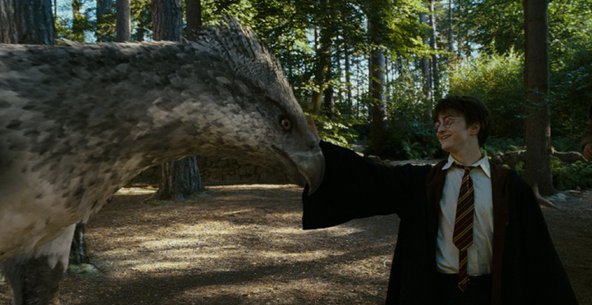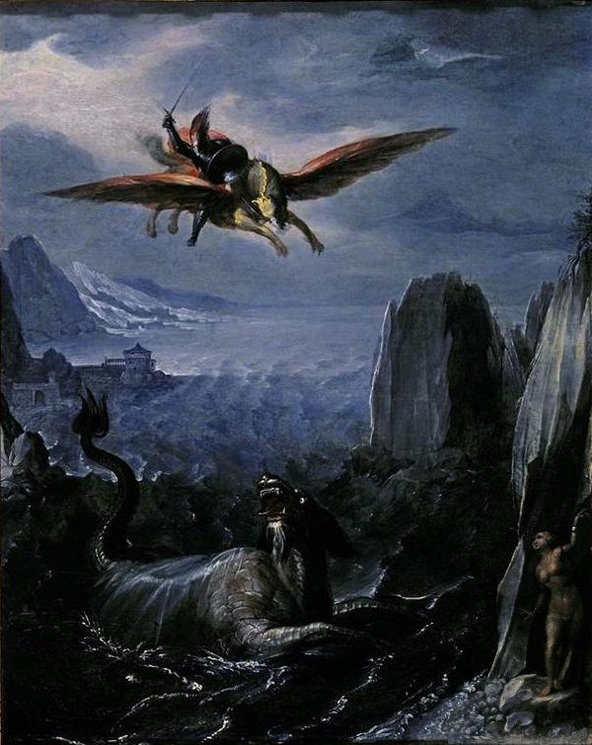Ariosto, Harry Potter and Hippogriffs: weaving textual webs
by Dr Stefano Jossa
23 Mar 2016

Nobody would fail to recognise a hippogriff. Although non-existent, hippogriffs are now known to everybody: the Harry Potter saga – both in the novel and film version – has made them so popular that even the most highbrow readers could not avoid acknowledging their awareness of them.
However, few perhaps would connect Buckbeak, Harry Potter’s hippogriff that first appeared in 1999 in The Prisoner of Azkaban, to his progenitor, the hippogriff invented by the Italian poet from Ferrara Ludovico Ariosto (1474-1533).
Much to his dismay, John Granger, the esoteric interpreter of Harry Potter, has reluctantly admitted that the hippogriff is not the product of Rowling’s sparkling inventiveness, as he had hoped, but ‘the creation of a sixteenth-century Italian court poet called Ludovico Ariosto in his Orlando Furioso’.
If Granger had read either Italo Calvino’s The Castle of Crossed Destinies or David Lodge’s Small Worldor Salman Rushdie’s The Enchantress of Florence or Russell Hoban’s Angelica Lost and Found, he would not have been so surprised to find Ariosto in the background of a contemporary, well-educated writer of popular fiction such as J.K. Rowling. Author of a lengthy poem of love and adventure, Orlando Furioso, Ariosto has been an incredibly fertile imagination for later writers when it comes to narrative combinations, sexual encounters, religious conflict and fantastic creatures. His poem raises issues of gender, identity, otherness and the position of the individual in the world in such a modern way that he can be rightly considered the precursor of the modern novel, as Sir Walter Scott had no difficulty in acknowledging. It would therefore make perfect sense that a writer as creative and imaginative as Rowling should have Ariosto in her cultural background. Nevertheless, even though repeatedly admitting that the hippogriff comes from literary tradition, Rowling herself has never mentioned Ariosto and acknowledged Orlando Furioso among her sources. Lapse of memory or simply typical writer’s tricks?
No need to go that far. Things are less obscure than they might appear: known to have been a passionate reader of epic fictions when a student at the University of Exeter, Rowling was more than likely aware of Bulfinch’s Mythology, the collection of ancient and medieval legends gathered by the American banker and Harvard graduate, Thomas Bulfinch (1796-1867). In the third volume of the collection, Legends of Charlemagne, or Romance of the Middle Ages (1863), Bulfinch presents his readers with the hippogriff: ‘He was a natural animal, of a species which exists in the Riphaean mountains. Like a griffin, he had the head of an eagle, claws armed with talons, and wings covered with feathers, the rest of his body being that of a horse. This strange animal is called a Hippogriff.’ (chap. 8)
Bulfinch is undoubtedly drawing his information from Ludovico Ariosto’s Orlando Furioso, where the hippogriff appears in canto 4.18: ‘The horse was no figment – he was real, begotten by a gryphon out of a mare. He had his father’s wings and feathers, his forefeet, his head and beak; in all else he took after his mother. He was known as a hippogryph – they are a rare breed, from the Rifean hills, way beyond the frozen sees.’ (trans. Guido Waldman)
Bulfinch’s reference to the Riphaean mountains (a mythological range mentioned by many authors of classical antiquity, such as Aristotle, Hippocrates, Ptolemy, Plutarch, and Pliny the Elder, among others, usually identified with the Urals) makes explicit what was only implicit, that his source lies in Ariosto’s poem: all the more so, since the hippogriff is mentioned in chapter 8, devoted to ‘Bradamante and Rogero’, one of the three main plotlines of Orlando Furioso, and Ariosto is namely mentioned in chapter 1 amongst ‘the principal Italian poets who have sung the adventures of the peers of Charlemagne’, together with Pulci and Boiardo. Depending – aware or unaware, doesn’t really matter – on Bulfinch, who in turn depends on Ariosto, Rowling too will be depending on Ariosto, if we consider the notion of intertextuality, which defines the presence of a text in another text independently of whether it is intentional. What makes Rowling’s fans pretty sure that she is drawing her hippogriff from Bulfinch rather than Ariosto, is that Rowling’s hippogriffs have an eagle’s head and a horse’s body (as is said in The Prisoner of Azkaban and later reiterated in Fantastic Beasts and Where to Find Them, published under the pseudonym of Newt Scamander in 2001), in contrast to Ariosto’s, which has a griffin’s head and a horse’s body.

'Ruggiero Saving Angelica', by Girolamo da Carpi, El Paso Museum of Art.
Bulfinch is therefore the likely literary mediator between Ariosto and Rowling – though we should not overlook visual interpretations of the hippogriff, such as those by Girolamo da Carpi, Louis-Èdouard Rioult, Johann-Peter Krafft and Gustave Doré; and should not forget subliminal mediations either, such as, perhaps, that of J.R.R. Tolkien, whose work is a major influence on Rowling’s writings and whose The Fellowship of the Ring was compared to Ariosto’s inventiveness by C.S. Lewis on the blurb of the book on its very first appearance in 1954.
Appropriation, as is well known, is a key feature of postmodern art. Rowling would not be doing other than appropriating Ariosto in a postmodern fashion, as well as following in the footsteps of earlier writers who had already appropriated Ariosto in various ways, such as Edmund Spencer, William Shakespeare, John Milton, Sir Walter Scott and Lord Byron. Yet Ariosto, in turn, was appropriating preceding tradition.
First and foremost, the winged horse of Greek mythology, Pegasus, which is the means through which Perseus frees Andromeda who has been exposed to a marine monster, as told by the Pseudo-Apollodorus (1st-2nd century AD) in the Bibliotheca (II, iv, 3-5) and Ovid (43 BC – 17/18 AD) in the Metamorphoses (IV, 668-764). The comparison is all the more striking since it will be while riding the hippogriff that Ruggero liberates Angelica, who has similarly been exposed to a marine monster, an orca, in canto 10 of Orlando Furioso. A similar word to hippogriffs (in the form ‘Hippogypians’: Ἱππόγυποι) was also present in the Greek satirical writer Lucian of Samosata’s True History (2nd century AD), where they are men riding on large vultures and using the birds for horses, a sort of sky variant of centaurs. The fact that they appear on the moon in chapter 11 of True History makes the connection with Ariosto even more likely, since it is the hippogriff that will carry Astolfo to the moon in canto 34 of Orlando Furioso. Was Ariosto already appropriating past tradition in a postmodern fashion as Rowling is? Or is Renaissance imitation a concept not too far from postmodern ideas of adaptation and appropriation? Even though texts relate to life and history, experience and reality, texts also recall other texts, in a web of relations which is what anthropologist Clifford Geertz has called the culture’s web of significance: ‘a system of inherited conceptions expressed in symbolic forms by means of which people communicate, perpetuate, and develop their knowledge about and attitudes toward life.’
To what extent are Ovid and Lucian, Pegasus and Hippogypians, present in Buckbeak’s background too? Dismissing the question would be the wrong approach: through Ariosto, they are indirectly yet literally connected to Rowling’s hippogriff. Texts are tissues of quotations drawn from innumerable centres of culture, as Roland Barthes explained some forty years ago. The vogue for Structuralism has passed out of fashion, we know, yet the proposition that texts contain more than they say is still valid. It does not really matter whether actual contacts were in place: the important thing is that we, as readers, are in a position to put the texts together and compare them. This is intertextuality. Rowling’s intertextuality speaks for literature as an often unconscious yet unavoidable fabric of interwoven texts
Paul Valéry, the French poet (1871-1945), once dreamed of a history of literature understood ‘not so much as a history of authors and the accidents of their careers, or that of their works, than as a History of the mind, insofar as it produces or consumes literature, and this history might even be written without the name of a single writer being mentioned.’
Jorge Luis Borges, the Argentine writer (1899-1986), dreamed as well of substituting the real world with a world of books as a universe of more inexhaustible interconnections than the one in which the books are actually penned: books would recall and remind us of other books in an infinite chain of correspondences where readers can find all sort of bonds with each other. And Umberto Eco, the recently deceased Italian writer and critic (1932-2016), spoke of literature as an encyclopedia where an infinite variety of connections can be made in order to improve human knowledge. Rather than still clinging to the idea of creative genius, a Romantic invention, we should be now aware that all the world is a web and the threads to the web are what makes our lives fascinating. This is a lesson that Ariosto may well teach us.
Dr Stefano Jossa is Reader in Italian at Royal Holloway, which he joined in 2007. He is the author of Ariosto (il Mulino, 2009) and was a convenor of Ariosto, the Orlando furioso and English Culture, 1516-2016.


